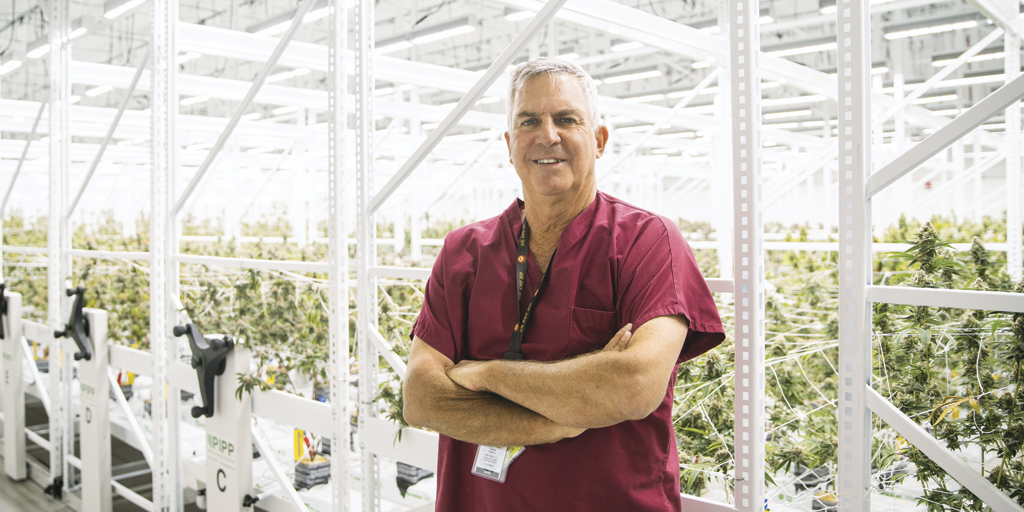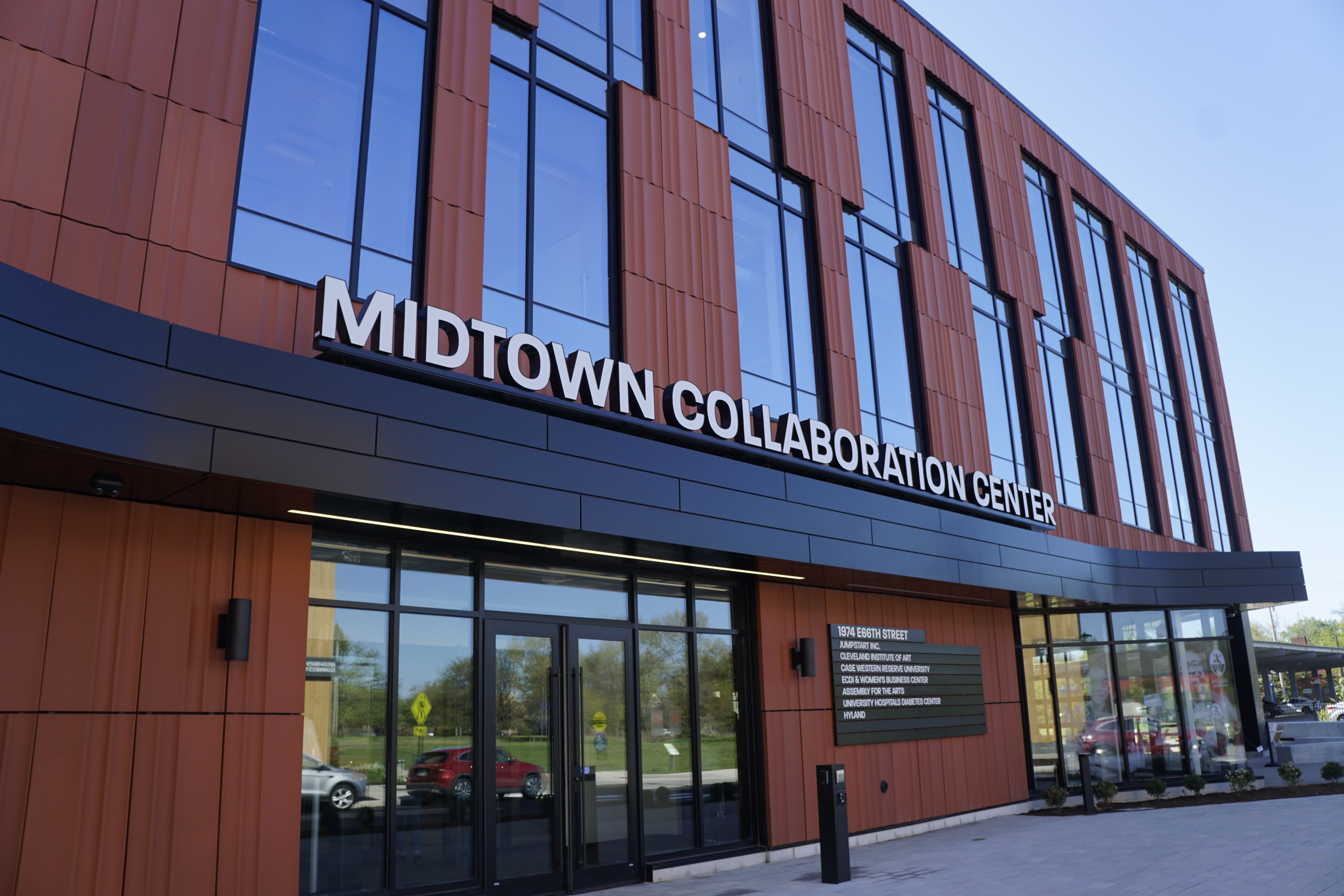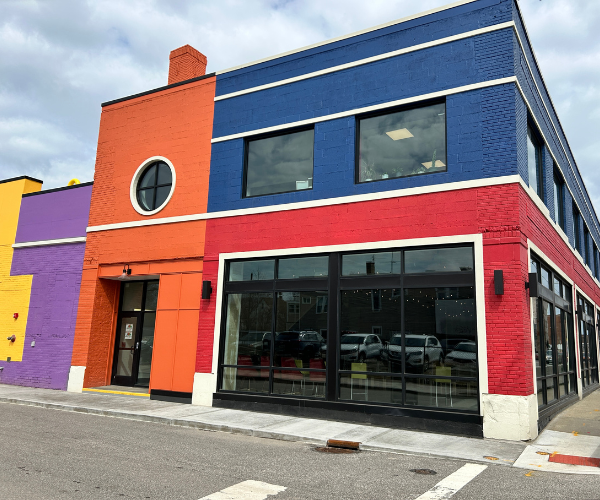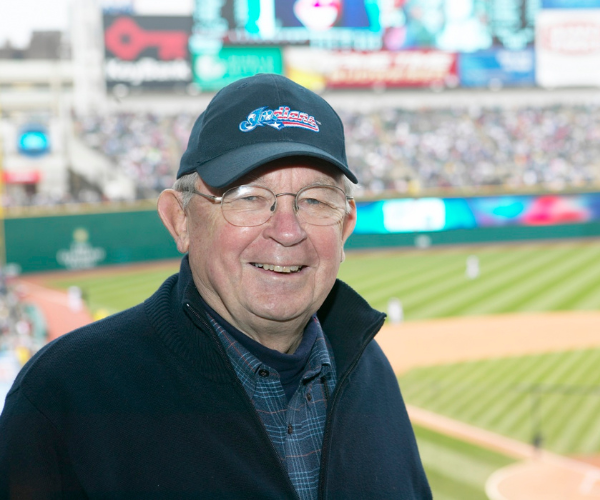Andrew Rayburn's Higher Calling
by Pat McManamon | Nov. 4, 2019 | 1:00 PM

PHOTOGRAPHED BY EVAN PRUNTY
Andrew Rayburn could sense the panic through the phone.
As the founder, majority investor and CEO of Buckeye Relief, he’d been working for two years to get the first large-scale marijuana cultivator in the state of Ohio off the ground.
While offsite on a mid-January Monday, he called the Eastlake facility to check in with his team. But what came through the other end of the line was a mild sense of dread.
The state of Ohio had just approved the certificates of operation for its first four medical marijuana dispensaries, with two near Steubenville and one each in Canton and Sandusky.
That was the good news. The bad news: The dispensaries were opening at 9 a.m. on Wednesday, less than two days away. Buckeye Relief needed to get hundreds of pounds of marijuana packaged, registered and shipped.
More than 3,500 patients diagnosed with a variety of conditions that could include cancer, fibromyalgia and Parkinson’s disease were registered to purchase medical marijuana and were waiting to fill their prescriptions.
So Rayburn put out an all-hands-on-deck call. Every one of his 18 employees responded, working frantically on Buckeye Relief’s first entry into the market. Job descriptions didn’t matter. Office administrators worked with growers packing dried marijuana flowers into vials, which had to have a tamper-evident seal, proper labeling and registrations to meet state requirements.
“I put a T-shirt on and went back and joined everybody and made sure I had the least dangerous job so I couldn’t screw anything up,” Rayburn says. “I think I was putting the caps on the jars.”
Rayburn ordered pizza and the pace continued for hours.
“I’m not sure that everybody even went home,” says Rayburn.
Since that first frenzied shipping day, Buckeye Relief has become Ohio’s first licensed marijuana growing facility to harvest and send flower to dispensaries, making Rayburn one of the most influential and important business owners in Ohio’s medical marijuana industry.
His 60,000-square-foot facility in Eastlake boasts 25,000 square feet for growing marijuana alongside rooms for drying, testing and packaging and a state-of-the-art hydroponic watering and fertilizing system. But success didn’t happen overnight, with Rayburn not seeing a profitable month until this August. With governmental delays, the state has been slow to become a leader in the medical marijuana industry.
But as the first president of the Ohio Medical Cannabis Industry Association, Rayburn is in the rare position to make an impact on a budding field.
“The business is unique, and it’s a startup,” he says. “There’s a lot of frustration and challenge and success and exhilaration.”
With more than 15 harvests completed, Buckeye Relief continues to push itself to learn the business’s best practices. This includes conducting ongoing research on CBD products, expanding its offerings to include Wana gummies made with a Colorado partner’s proprietary formula and chocolates made in an on-site kitchen.
“It’s really fascinating being a part of a brand new industry in the state,” Rayburn says. “We’re literally figuring it out as we go.”

At 64 years old, Rayburn admits he smokes marijuana. Like many in his generation, he smoked for the first time in high school. Today, Rayburn considers himself an occasional user, although for very different reasons — he has glaucoma, and his medical marijuana card provides him relief when the condition flares up from time to time.
“You can feel that coming,” he says. “It’s not a regular thing, but it’s nice to have [marijuana]. It has no side effects.”
Rayburn’s personal impetus for diving into the cannabis business came in 2015, when a friend he’d known for decades was sent to hospice care near the end of a 12-year fight with multiple myeloma.
The cancer, which damages the bones, immune system, kidneys and red blood cells, had been extremely difficult. But soon after going into hospice, he called Rayburn to tell him he smoked marijuana for the first time.
For the first time in two years, Rayburn’s friend didn’t feel miserable. He had slept through the night and eaten real food when he woke up.
Tears welled in Rayburn’s eyes. He wiped them away as his friend asked, “What do you think about all that?”
Rayburn’s answer: “I think you should smoke some more marijuana.”
The pair had grown up together on the East Side of Cleveland and watched their fathers play golf together. They had also worked together, played a lot of golf themselves and often argued about who was the better golfer.
“He was one of those tough Irish guys that played football, basketball and baseball,” Rayburn says. “That’s why he was able to fight cancer so long, in my opinion.”
His friend’s experience made the idea of starting a medical marijuana company a personal passion for Rayburn. In 2016, he started attending national conferences to learn what he could, and he and his business partner Scott Halloran visited production facilities, mainly in Colorado and California.
Research had shown medical marijuana could relieve pain and anxiety, and be used to treat depression and Crohn’s disease. Today, Ohio allows medical marijuana use for 21 qualifying conditions, including PTSD, traumatic brain injury, Parkinson’s, Alzheimer’s, HIV, AIDS and epilepsy.
The more Rayburn learned, the more he believed. And while he admits there is a profit margin to any business, a driving force was to do something that would benefit people like his friend.
“One of the biggest rewards is having people tell me their stories, whether it’s their direct story, or about their father or friend,” he says. “And it doesn’t get old. It never does.”
Stories have even come directly from Buckeye Relief employees. As the company’s cultivation technology director, Jeremy Shechter ensures the right amount of water, fertilizer, carbon dioxide and light is delivered to each plant using a central automated environmental control system. He also has his own card to relieve chronic back pain.
“I developed a love for working with the plants and developing the systems that keep them alive,” he says. “It’s probably one of the most challenging plants of our time, due to the lack of research around the plant and understanding of it, because it’s been illegal for so long.”
Rayburn doesn’t wait in his office to greet visitors. Instead, he walks out to the entrance to shake hands and introduce himself.
The Grateful Dead devotee and former minor league baseball team owner doesn’t look like your typical high-level executive. His untucked, pale green shirt with brown pants and canvas shoes suggest a more easygoing approach to doing business.
“It’s sure fun to learn,” he says. “We’re proud of this facility and it speaks a lot about the way we do business.”
With a career that’s spanned many different industries and taken a few unusual paths, Rayburn has always been successful, gaining knowledge and insight along the way.
He spent a few years working in sales for a wine company while living in a $400-a-month apartment in Sausalito, California. But he returned to Cleveland in 1979 and took over Flexalloy, an industrial distribution business that sold parts for heavy trucks such as Freightliner Trucks, in 1981. Over 18 years he helped it grow from one office and 20 employees to locations in 13 cities, including ones in Canada and Mexico, with 385 employees.
Rayburn had gone into debt to secure the company though, and when the opportunity to sell and erase that debt came along, he took it. On April 10, 1999, Rayburn sold Flexalloy, setting him up for life.
“I celebrate that day every year,” he says.
In 2000, he founded Big Game Capital, a private equity investment firm that dipped a toe in the water of medical marijuana by investing in cannabis companies and ancillary businesses that provided insurance and financial support. He also bought a minor league baseball team and became a minority owner of the Cavs.
The baseball venture started in 2000 when he purchased the Daytona Cubs, a High Class A minor league team in Florida now called the Tortugas.
“It was for sale and it was about a minute from the beach,” says Rayburn.
During his introductory press conference, a fan Rayburn dubbed “Front Row Joe” because he attended more than 1,000 consecutive games, asked what the new owner knew about running a team.
“I said, ‘I don’t know anything about running a baseball team, but I know a lot about being a baseball fan,’ ” says Rayburn.
That kind of honest, can-do attitude has helped Rayburn take risks, attract investors and garner loyalty from his employees.
It shines through at Buckeye Relief when he gives tours of the facility, where the hallways are polished clean and Grateful Dead posters and photos of Cleveland taken by his wife Heather hang on the walls.
He dons scrubs and fist-bumps
employees while advising visitors not to touch the plants.
“We want to educate people as to the controls, the precision, the cleanliness and the sterility of our operation,” says Rayburn. “It is all done to promote high quality and prevent contamination.”

Growing and processing marijuana is complex.
It requires a dedicated team of horticulturalists, engineers and a chef. Growing rooms at Buckeye Relief have the earthy, unmistakable aroma of vegetation grown in pristine conditions. Temperature, light, fan-driven wind and humidity are closely controlled to maximize the benefits of the product and to produce the right balance of THC, the psychoactive element in marijuana, and CBD, a therapeutic but non-psychoactive element. Consistency from one harvest to the next is vital, which is why Buckeye Relief only uses clones from the 125 best plants from an initial planting of 10,000 seeds.
“It’s complicated,” Rayburn says. “What we’re operating here is an alternative pharmaceutical company with a natural product. We’ve tried to go to the highest level of quality and excellence in everything that we’ve done.”
The constant has been the ability to adjust. As the plant has been refined and perfected, so have the growing and distribution techniques.
“The way we were doing things from July of last year to January of this year, we’re doing almost everything differently,” he says. “It’s challenging, because it’s a very finicky plant.”
The plants grow in a man-made mineral fiber called rockwool, which allows for maximum absorption of nutrients and water. They go through a cultivation process that takes them through three different rooms at various stages of growth.
Buckeye Relief planted its first 10,000 seeds on July 31 last year. Half the ensuing plants were eliminated, since only female plants are used in the facility to produce larger buds. Up to another 3,000 were eliminated because they were self-fertilizing hermaphrodites. The final cut became the 125 plants originally used for cloning. These clones are housed in what they call the “mother room,” a low-lit densely populated room which has the feel of a jungle.
The company now has about 300 “moms” that produce 38 carefully selected strains of marijuana. Every three weeks, about 60 moms are cloned, then killed to keep all plants below a certain age to improve the health and quality of buds that are cut. Meticulous research and a burgeoning database keep track of each plant as well as the successes and failures of each approach.
Once plants are cloned, they are moved to the “clone room,” where about 3,000 tiny sprigs populate the environment. The growth process is staggered to ensure consistent harvests. Teenage plants grow in the vegetation room, and when they reach adulthood, they are moved to one of three flower rooms, where rows and rows of some 2,000 plants produce the fuzzy flower that is used for medicinal purposes. It is in this room that the aroma of marijuana is most prevalent.
Each plant has a yellow tag for state identification purposes. Once harvested, plants are hung to dry for about a week, then cured slowly in small batches for up to two weeks until the buds are at an ideal moisture content. The flower is trimmed by hand, then sent to the packaging room where it is processed and mailed to dispensaries. A rigorous in-house testing system ensures product consistency.
Since its first harvest in January, Buckeye Relief has grown to 58 employees. Rayburn says the company had 500 applications within 24 hours of posting his last ad for a job opening. He believes the product and the fact that the company is a startup has allowed him to hire a unique, notably dedicated staff.
“It’s a new industry, an exciting industry and an alternative industry,” says Rayburn. “So we draw particular interest from young people.”

Like any startup, Buckeye Relief has had its struggles — finding community support, building a facility and ensuring there was enough capital to support the business in its early months. But Rayburn has had to deal with issues peculiar to the medical marijuana industry, especially an industry that is just starting to find its footing in Ohio.
The state was slow to roll out its Ohio Medical Marijuana Control Program, a move that has been criticized by the medical community at large. The program was originally slated to begin in September 2018, but didn’t get product to patients until dispensaries opened four months later — in January 2019.
As of September, the state’s 561 certified physicians who qualified for issuing medical marijuana prescriptions had issued more than 55,000 recommendations for patients. As of Oct. 6, 40,571 patients had purchased it from a licensed dispensary. The number of users pales in comparison to Pennsylvania’s first year with medical marijuana, which started in February 2018. This February, that state had 116,000 registered patients and 83,000 users.
In August, Ohio’s State Medical Board had also declined to include anxiety and autism on the list of 21 conditions approved for medical marijuana. Most states have one governing body, but in Ohio regulation falls under three state licensing boards — pharmacy, medical and commerce.
Answering to three bosses can be demanding. But Rayburn loves a challenge. And as the first president of the Ohio Medical Cannabis Industry Association, he’s taking this one head-on.
“We want to present a unified voice from the industry on all relevant issues,” says Rayburn. “We’re a group of cultivators, processors and dispensaries who are dedicated to presenting the industry’s point of view.”
With reports projecting the sales of cannabis to grow nationally at a 17% rate to $13.1 billion by 2025, now is the time for Rayburn to get ahead in a growing market.
Ohio now has 32 cultivators with an operating license like Buckeye Relief, while 36 of 56 dispensaries have been given certificates to operate. As of Oct. 6, 3,810 pounds of plant material worth $31.7 million have been sold in Ohio through 238,360 transactions.
Rayburn estimates that Ohio will eventually have 200,000 medical marijuana cardholders, but for now, Buckeye Relief is growing in the right direction.
“We’re accelerating,” he says. “When we return to the conversation months or years from now, when a close relative uses our products and benefits from them — whether that’s somebody at the latter stages of their life in hospice or someone suffering from one of the 21 approved illnesses — then let’s have a discussion after you’ve seen what this can do and how beneficial it’s been.”
For more updates about Cleveland, sign up for our Cleveland Magazine Daily newsletter, delivered to your inbox six times a week.
Cleveland Magazine is also available in print, publishing 12 times a year with immersive features, helpful guides and beautiful photography and design.
Trending
-
1
-
2
-
3
-
4
-
5










